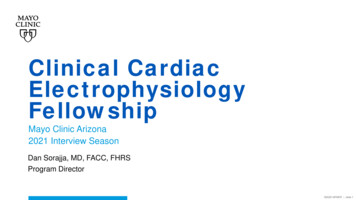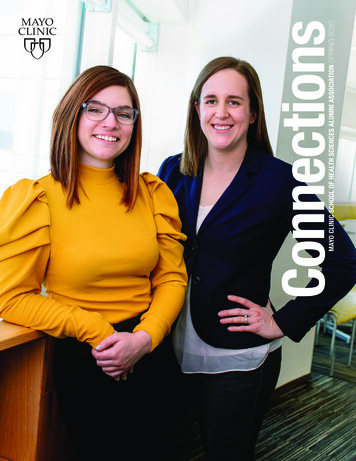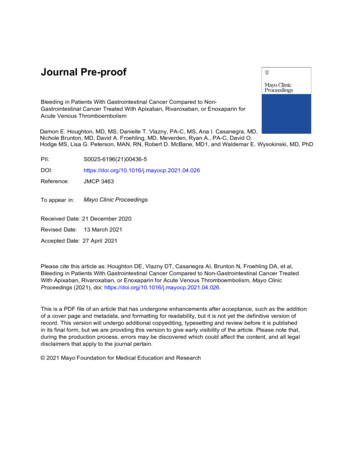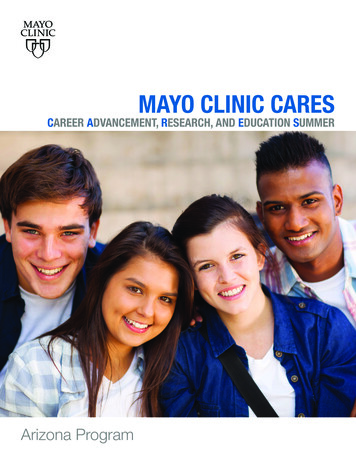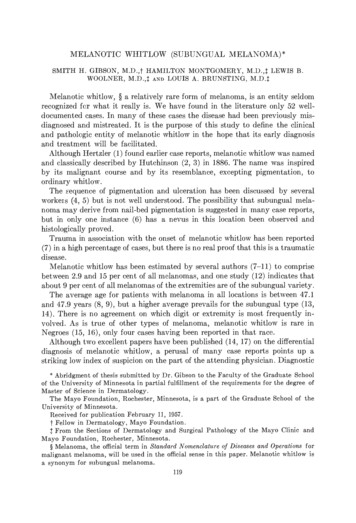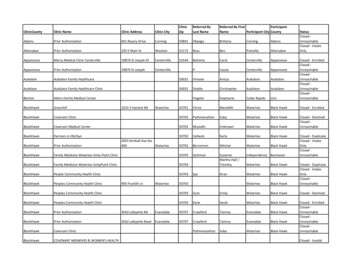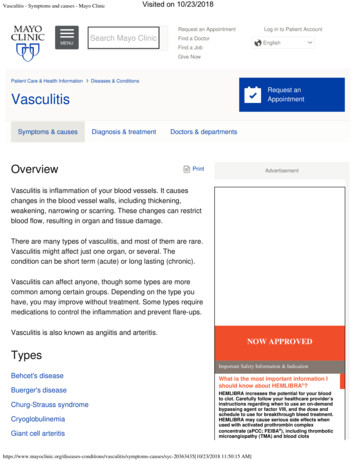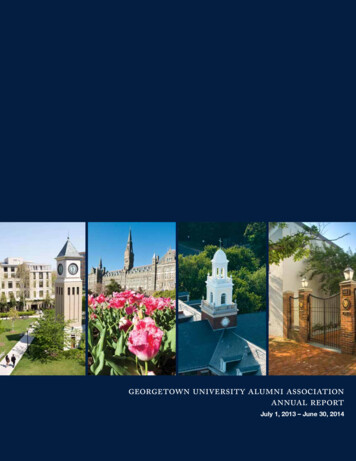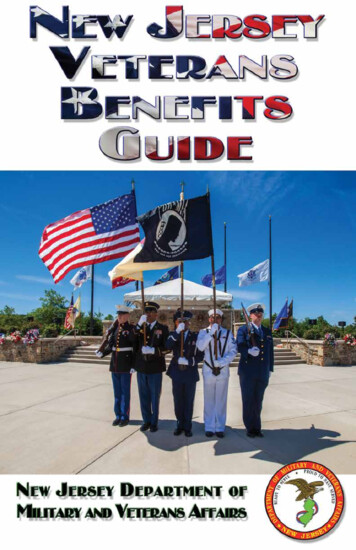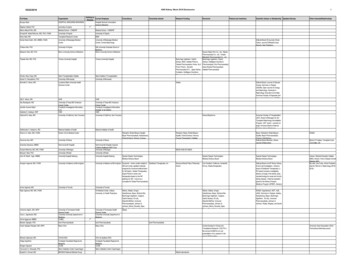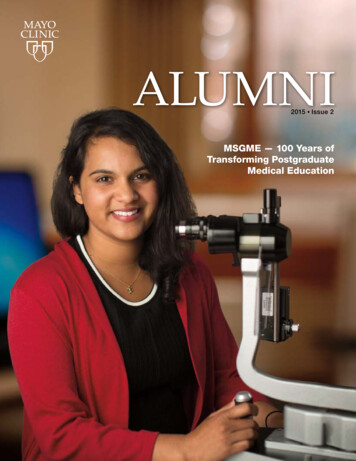
Transcription
2015 Issue 2MSGME — 100 Years ofTransforming PostgraduateMedical Education
CONTENTS2015Issue 26102628FEATURESMayo Clinic Kern ScholarsProgram 2Training clinicians to assess health care delivery systemsMSGME 100 6A transformational force in postgraduatemedical educationNew CEO in Florida 10Gianrico Farrugia, M.D.Your digital identity 24The importance of engagingWhere are they now? 26Pregdrag Lalevic, M.D., Ph.D.Kendall and Balfour awardrecipients 28Meritorious research recognizedBiennial meeting 12Know your Boardof Directors 32Mark your calendarProfiles of representativesMayo Clinic AlumniAssociation at 100 13MAYO UPDATE 35Carrying the torch handed fromthe Mayo brothersMayo Medical School news,Board of Trustees news,obituariesABOUT THE COVER Mayo School of Graduate Medical Education’s Saranya Balasubramaniam, M.D. (I-1 ‘13, OPH ‘16),is a resident in ophthalmology — one of more than 270 training programs covering every medical and surgical specialty acrossall Mayo Clinic campuses. The school oversees the largest number of accredited programs in the United States.
A Letter from theSecretary-TreasurerThis issue of Mayo ClinicAlumni is chock-full ofinformation, includingthe second of fourspecial sections about the AlumniAssociation’s 100th anniversary.I’m humbled when I read about thegoings-on at Mayo Clinic duringWorld War II, the outstandingcontributions to aviation medicine,the Kendall-Hench Nobel Prize andso much more. Mayo Clinic alumnitruly do stand on the shoulders ofgiants. It makes me wonder whatwill be written about our generation50 or 100 years from now. Perhaps itwill include the accomplishments ofyoung physicians and scientists suchas our current Kendall and Balfouraward recipients (page 28), whoseimpressive work is changing theface of medicine.The Alumni Associationcontinues with a full slate ofactivities designed to help youconnect with other Mayo alumni. Inthe fall I attended the internationalAlumni Association meeting inIreland, and I will be at the biennialmeeting in Arizona in October. Igo to alumni meetings with someidea of whom I’ll encounter, yetI’m consistently surprised by a newacquaintance or a reconnection. TheMayo brothers spoke often aboutthe importance of alumni remainingin contact with each other andwith Mayo Clinic. I encourage youto consider attending the biennialmeeting in Arizona (page 12) orthe just-announced internationalmeeting in Whistler, BritishColumbia, Canada, in June 2016.And don’t forget our regionalmeetings, which occur around thecountry throughout the year, andalumni receptions that we hostat more than 60 major specialtysociety meetings every year. Theseare announced regularly on ourWeb-only stories1 The first four Mayo graduatesin the Mayo Foundation Universityof Minnesota joint program totrain specialists in 1917 (page 6)were Della Drips, M.D. (I 1924)(pictured at right), DorothyPettibone (CM 1917), EgertonCrispin, M.D. (I 1916), and FrancisMcMahon, M.D. (S 1917). Learnmore about these education pioneers.Peter C. Amadio, M.D. Secretary-TreasurerMayo Clinic Alumni Association L loyd A. and Barbara A. AmundsonProfessor of Orthopedicsnew website (alumniassociation.mayo.edu) and by email, so besure that we have your currentelectronic address. Please use thewebsite to update your contactinformation, to connect withfriends old and new, and, of course,(I have to say this; I am, after all,your treasurer) to pay your dues. Ilook forward to seeing you soon!alumniassociation.mayo.edu2 Gianrico Farrugia, M.D. (I ’91,GI ’94), a 26-year veteran and vicepresident of Mayo Clinic, is thenew chief executive officer of MayoClinic in Florida (page 10). In 1990he was featured in a Mayovox storyabout international visitors learningthe Mayo way. Read about this thensecond-year resident from Malta.12Issue 2 20151
Mayo Clinic Kern Scholars ProgramTraining clinicians toassess health caredelivery systems In 2010 Mayo Clinic’s Robert D. and Patricia E. KernCenter for the Science of Health Care Deliveryestablished a scholars program to allow doctorallevel health professionals to rigorously studyinnovative models of care delivery to create high-value,trusted, affordable health care.The objective of the Mayo Clinic Kern ScholarsProgram is to transform health care delivery by improvingoutcomes through training a highly skilled group ofclinicians in health services research.Testing ‘what we’ve done intuitively’to make sure it’s correctJon Tilburt, M.D. (I ’07), Division of General InternalMedicine and director of the Kern Scholars Program,says the program is a natural extension of Mayo Clinic’spatient-focused values for health care delivery. “The waywe have structured care at Mayo Clinic has been doneintuitively through the second half of the 20th century,”he says. “But health care is always subjected to rigoroustesting, so in the 21st century we need to step backand test to make sure that what we’ve done intuitivelyVeroniqueRoger, M.D.Jon Tilburt, M.D.2MAYO CLINIC ALUMNI
In the Scholars Program I foundenthusiastic faculty willing to mentorand peers to interact with. It becamean academic home for me.”–Nneka Comfere, M.D.is correct. We need this evidence to continue being aleader in high-quality care that influences others.”Dr. Tilburt explains why evidence-informed healthcare requires more rigorous scrutiny than has beenapplied so far. “We must assess existing health caredelivery systems, test different care models and applythe best practices to improve those systems,” he says.“To do this, we need a workforce of practicing clinicianswithin Mayo Clinic who have the necessary researchskills, protected time and scholarly track record toundertake high-quality practice-based health servicesresearch that can improve the delivery of health careand influence the structure and quality of U.S. healthcare. We can and should lead in health services research.”The Kern Scholars Program involves: Mentorship and guidance through the research process Personalized training in health services research(using the disciplines of social sciences) and grantwriting (scholars apply for competitive extramuralcareer development awards or federal project awardsbefore completing the program) Frequent interaction with other scholars and facultyVeronique Roger, M.D. (CV ’88, CV ’92), Divisionof Cardiovascular Diseases, medical director of theMayo Clinic Center for the Science of Health CareDelivery and the Elizabeth C. Lane, Ph.D., and NadineZimmerman, Ph.D., Professor of Internal Medicine,says, “We are incredibly proud of our scholars. Theyare the future of our center. They share our commonpurpose in defining the care that our patients receivenow and in the years to come.”Mayo Clinic Alumni profiles several recent KernScholars and their projects.Studying deficits in communication thataffect timeliness and accuracy ofdermatology diagnosesNneka Comfere, M.D. (MMS ‘01, I-1 ‘02, DERM ‘05,DPATH ‘06), Department of Dermatology, was a KernScholar for three years, completing the program inJune 2014. Her research focuses on communicationbetween dermatologists and pathologists.“Deficits in communication can lead to delays indiagnosis and affect diagnostic performance in termsof specificity, accuracy and speed,” says Dr. Comfere,a clinical dermatologist and dermatopathologist. “Thiscan result in failure to meet patients’ expectations abouttimely biopsy results and unnecessary anxiety for them.”Dr. Comfere says she has always had a passionfor systems and care processes. “Prior to the ScholarsProgram, my research experience was limited toretrospective clinical studies,” she says. “In the ScholarsProgram I found enthusiastic faculty willing to mentorand peers to interact with. It became an academichome for me.”Dr. Comfere says dermatology is underrepresented inhealth services research — focusing on how diseasespresent rather than care delivery. She conducted a largenational survey of dermatopathologists to learn moreabout the information submitted to them by clinicians.She identified specific clinical information not provided inrequisition forms and is exploring ways to affect processesat the point of care to improve accurate, timely diagnoses.Dr. Comfere explains the current clinical process:“A clinician sees a patient and gets a biopsy. The biopsygoes to the pathologist, who generates a report based oninformation supplied by the clinician. The clinician getsthe report, interprets it and makes a decision about howIssue 2 20153
I’ve grown from a junior investigatorto one who asks her own questionsand can become an independentinvestigator. I look at how wepractice with a more critical eye.”–Carrie Thompson, M.D.best to treat the patient. A lot of miscommunication andmisunderstanding can occur. I’m hopeful that throughmy investigations, I might get a better understandingof what the pathologist needs to render a meaningfulreport to the clinician, and what the pathologist needsfrom the clinician to interpret the skin biopsy specimensappropriately.“I’m continuing my research outside of the programnow. The Scholars Program experience taught mevaluable foundational aspects of health servicesresearch. This work isn’t about pathogenesis or thenatural history of disease. Instead we’re looking atoutcomes of patients who receive care every day andthe systems and structures that support their care. It’sworthwhile because we ensure that the right care isprovided to the right patient at the right time.”Investigating the cancer survivorship experience,affecting the standard of practiceCarrie Thompson, M.D. (I ’04, HEMO ’07), Divisionof Hematology, completed her two-year Kern ScholarsProgram a year ago. Her research focused on qualityof-life and long-term issues in survivors of hematologiccancers.“Cancer survivors are a growing population in theUnited States and underrepresented in research,” saysDr. Thompson. “Health care delivery is an importantpart of our practice and needs to be part of our research.I wouldn’t have been able to accomplish the work I didwithout the Scholars Program.”Dr. Thompson established a lymphomasurvivorship clinic at Mayo Clinic in Rochester,studying the impact of cancer on patients afterlymphoma treatment, advising them about signs of4MAYO CLINIC ALUMNIrelapse and effects of cancer treatment, and providingscreening recommendations. She is comparingoutcomes in those who participated in the clinic withthose who did not, as well as quality-of-life measuressuch as fear of recurrence and anxiety.“Providing care for survivors is part of the cancertrajectory that was missing,” she says. “Patientsappreciate the opportunity to review what they’vebeen through, talk about the psychological effects,and learn about recommendations for ongoing healthand wellness.”Dr. Thompson found that patients cured fromaggressive lymphoma were being over-tested duringtheir follow-up care. As a result of her research, Mayo’shematology practice has changed the number of followup scans it conducts. International guidelines also havechanged due in part to her research.“Lymphoma patients get anxious about fear ofrecurrence around the time they’re due for scans, andwe expose them to unnecessary radiation,” she says.“If our standard of care isn’t improving outcomes andisn’t cost effective, we shouldn’t do it. I’m proud to havemade an impact on lymphoma patients here and maybearound the world.”Dr. Thompson says she has developed through theKern Scholars Program. “The program is training juniorfaculty and fellows within Mayo Clinic to do health caredelivery research,” she says. “I’ve grown from a juniorinvestigator to one who asks her own questions and canbecome an independent investigator. I’m a more curiousclinician now. I look at how we practice with a morecritical eye.“Mayo Clinic has always had an emphasis onexcellent patient care and cutting-edge research that
moves medicine forward. The Scholars Program isa unique spin on that — educating physicians abouthow we deliver health care to patients and providingadded value to already-excellent research. Focusingon improving and implementing best practices for thecare of all patients is very patient centered, and patientcentered care is important at Mayo Clinic.”Dr. Thompson is continuing her research with grantfunding from a Mayo Clinic benefactor.Examining how to safely de-escalateasthma medication useMatt Rank, M.D. (AIM ’08, CLRSH ’09), Division ofAllergy, Asthma and Clinical Immunology at MayoClinic in Arizona, spent three years as a Kern Scholar,finishing in 2014.His research focused on asthma management,including how to step down from medications whenasthma is under control. “For the last several decades,asthma research has focused on what to do whenthe disease is problematic,” he says. “What aboutwhen you’re doing well and can safely reduce yourmedication use?”Dr. Rank’s mentor Nilay Shah, Ph.D. (HSR ’05),Health Services Research, Mayo Clinic in Rochester,showed Dr. Rank how to use databases to understandthe risks, benefits and outcomes of reducing asthmamedications.“We demonstrated that safely reducing medicationuse reduces side effects and cost of care, and we outlinedthe risks involved,” says Dr. Rank. “As we continue theresearch, we plan to refine and validate prediction rulesfor patients and providers involved in reducing medications.Our goal is to provide a framework for de-escalatingmedications for patients with asthma that we hope canbe translated for other chronic diseases.”Dr. Rank received a grant from the Agency forHealthcare Research and Quality to continue his research.“The Scholars Program has been a huge boost tomy research career, helped me compete for externalgrants and provided me with close relationships withmultiple mentors,” he says. “As a young facultymember, it would have taken me much longer to getthere without the program. Mayo Clinic is investing inmaking our practice better — finding out what worksand spreading it through out the practice. We candeliver health care better.” About the Mayo Clinic Kern Center forthe Science of Health Care DeliveryThe Mayo Clinic Kern Center for the Science of Health Care Delivery appliesinnovative science and data to evaluate the quality, safety and value of healthcare globally and improve real-world experiences forpatients. Multidisciplinary teams focus on programsand themes, exploring the many facets of health caredelivery, developing proven methodologies and drivingimprovements into practice.The Scholars Program has been ahuge boost to my research career,helped me compete for externalgrants and provided me with closerelationships with multiple mentors.”–Matt Rank, M.D.Issue 2 20155
MSGME 100TRANSFORMING POSTGRADUATEMEDICAL EDUCATION6MAYO CLINIC ALUMNI
The reach of Mayo School of Graduate Medical Education(MSGME) is significant. The school oversees the largestnumber of accredited programs in the United States, withmore than 270 training programs covering every medical andsurgical specialty across all Mayo campuses.As MSGME marks its centennial in 2015, Mayo Clinic Alumnireflects on a key time in Mayo Clinic’s history. Along with theUniversity of Minnesota, Mayo Clinic played a significant rolein the evolution of medical training.Issue 2 20157
PresciencePrior to 1915 U.S. physicians could call themselvesspecialists without any training besides a medical degree.Two years before the Flexner report on medical schoolswas undertaken in 1908, William J. Mayo, M.D., thenpresident of the American Medical Association, said,”The profession owes it to itself to investigate whatthe schools are actually doing and to make it knownwhether or not they fulfill their obligations to the student.”PartnershipChristopher Boes, M.D.8James Moore, M.D., chief of surgery at the University ofMinnesota, communicated a strategy to Dr. Will in 1914:“The idea in brief is this, that instead of doing ordinarypostgraduate work, which I believe does more harm thangood, we as a University do real graduate work and offer aschool for the education of specialists. This will do a greatdeal to forward your scheme at Rochester [a new three-yearresidency program to train specialists], and will have muchto do with amalgamating your institution with theUniversity. With your help we are already in a position tooffer men courses in all of the recognized specialties.”In 1915 Dr. Mayo and his brother, Charles H. Mayo,M.D., established the Mayo Foundation for MedicalEducation and Research, a new legal entity distinct fromthe clinic. Income from the practice was placed in a trustto fund stipends for residents who came to Mayo Clinicto study after medical school and internship.Soon thereafter, Mayo Clinic partnered with theuniversity to develop the first three-year university-basedprogram to train graduate physicians in specialty practice.Applicants for the Mayo fellowship had to have graduatedMAYO CLINIC ALUMNIfrom medical school and completed an internship. Enrolleeswere expected to conduct research and publish papers.The first graduate degrees in Mayo’s programs wereconferred in 1917 — to two women and two men.ProgressThanks to the efforts of the Minnesota institutions,postgraduate medical education began to focus onspecialty training instead of continuing medicaleducation courses. This change followed a moreEuropean method of physician education at a timewhen access to Europe for training was narrowingdue to World War I.“Prior to this, practitioners could easily claim theywere ‘specialists.’ The Mayo brothers wanted to improvethe standard for training specialists,” says ChristopherBoes, M.D. (N ’00), associate dean of MGSME Rochestercampus and director of the Mayo Clinic Center for theHistory of Medicine. “Having a master’s degree or Ph.D.in clinical medicine or surgery was a brand new concept.Today, those degrees aren’t granted. Louis Wilson, M.D.,the first head of MSGME, helped move the focus to boardcertification as demonstration of specialty competency.”ProblemsThe affiliation for graduate medical education betweenthe university and Mayo Clinic stirred controversy. In1915 physicians from around the state protested theuniversity’s arrangement with a “private business firm”(Mayo Clinic). In 1917 legislators introduced a bill inthe state legislature to end the Mayo affiliation. Mayocountered by allowing its 1.5 million endowment of the
graduate medical school to be put under the immediatecontrol of the university regents. Wording was addedthat after approximately 28 years, the net income couldbe spent for graduate medical and surgical investigationand research work to be carried on at or directed fromthe University of Minnesota in Minneapolis or otherplaces (including Rochester).During the legislative debate, educational reformersincluding William Welch, M.D., from Johns Hopkinswrote in support of the affiliation:“The unequaled opportunity for graduate medicaltraining and work accorded by the affiliation of theUniversity of Minnesota with the Mayo Foundation hasmade your graduate school the envy of other institutions aswell as a source of pride to the country.”Adding to the challenges in the arrangement,each institution had different priorities — scientificinvestigation to create “productive scholars” andresearchers for the university, and “high-gradeapprenticeship” in the medical specialty residencymodel for Mayo Clinic. By the 1950s specialty boardcertification had replaced graduate degrees as thepath to specialization.The Rochester campus residency training programwas renamed the Mayo Graduate School of Medicinein 1964 and the Mayo School of Graduate MedicalEducation in 2004. The joint programs morphedinto specialty residencies and advanced fellowships,M.D./Ph.D. programs and graduate programsin sciences.The affiliation ended in 1983 when Mayo becamea degree-granting institution.Postlude“Although this affiliation didn’t survive, Mayo Clinic’sinfluence helped to ensure rigor in graduate medicaleducation in America. Mayo’s residency programfocused on patient care yet still emphasized clinicalresearch,” says Dr. Boes. “Many are unaware of thissignificant period in our history and Minnesota’s rolein specialty education reform.”Mayo School of Graduate MedicalEducation todaySteven Rose, M.D.(MMS ’81, I ’82, ANES ’84)Dean and Designated InstitutionalOfficial, Rochester campusDarrell Pardi, M.D. (GI ’98,CTSA ’09) Associate Dean,Medicine Pediatrics,Rochester campusChristopher Boes, M.D. (N ’00)Associate Dean, Medical andLaboratory Specialties,Rochester campusDavid Capobianco, M.D. (N ’91)Associate Dean,Florida campusEric Dozois, M.D. (S ’00, CRS ’01)Associate Dean, Surgery andSurgery Specialties,Rochester campusJoseph Mikhael, M.D. (HEMO ’08)Associate Dean, Arizona campusmayo.edu/msgmeGo to mayoclinicproceedings.org and search for The Founding ofMayo School of Graduate Medical Education for more information.Issue 2 20159
New CEO in Florida‘Palpable energy’ fuels Gianrico Farrugia, M.D.Gianrico Farrugia, M.D. (I ’91, GI ’94), avice president and 26-year veteran ofMayo Clinic, is the new chief executiveofficer of Mayo Clinic in Florida.Mayo Clinic Alumni spoke with himabout the new position and his plans.Why did you want to make the move toMayo Clinic in Florida?As director for the Center for Individualized Medicine,I had visited the Florida campus at least quarterly andgotten to know many people. I’ve become even moreaware of the power of building strong teams at MayoClinic and how doing so can transform our patients’lives. I didn’t want to pass up the opportunity to workwith staff in Jacksonville.In terms of timing, the research that I am so proudof is well positioned to progress in Rochester without myday-to-day involvement. This is possible because severalformer fellows in my laboratory have joined the MayoClinic staff and become successful in their own right.Finally, my sons are seniors in high school andcollege, so it was a good time to move personally.How did your predecessor in Florida, WilliamRupp, M.D. (ONCL ’08), help with the transition?He has been gracious with his time and wealth ofinformation. He made sure I understood the people, placeand large opportunities ahead. One of the first things hetold me was that I should spend a lot of my transition timejust walking around and meeting people. I took his adviceto heart and am very happy I did so. It has been extremelyhelpful. I met and learned from many and found out whereall the stairs are in the various buildings.What are your priorities?Patients come to Mayo Clinic in Florida from all 50 statesand more than 140 countries for our unique servicesin transplantation, neuroscience, oncology and otherspecialties. We’re already a destination medical center inour own right. My administrative partner, Christina Zorn,10MAYO CLINIC ALUMNIand I will work on expanding our ability to offer a destina tion medical center experience to all of our patients.We will continue to look at ways to develop ourresearch and education capabilities on campus and makesure we translate them into better outcomes for patients.Dr. Rupp and his administrative partner, Bob Brigham,left a very strong culture of quality and safety, and we’recommitted to continuing that culture.What are you most excited about in yournew position?We have a very strong staff and beautiful facilities, andwe offer outstanding value for our patients. The energyhere is palpable. There’s a genuine desire to make surethat our patients have an outstanding experience.Everybody who visits the Florida campus commentson how beautiful it is. Having the hospital connectedto the outpatient buildings, with research labs andeducation programs on the same campus, is a luxuryand very efficient. We’re committed to providing anoutstanding experience for patients and their families,and it is exciting to be part of this effort.Are you still director of the Center forIndividualized Medicine (CIM)?No. Keith Stewart, M.B., Ch.B. (HEMO ’05), Division ofHematology-Oncology, is the new medical director.Being the director of the CIM has been one of themost fulfilling times of my life. It has been remarkableto see the promise of genomics translate to the practiceof genomics for our patients. I will be excited to seethe CIM continue to grow and will cheer it on everystep of the way.What will you miss about Rochester?I was a resident, then a fellow, then a staff member at MayoClinic in Rochester. My sons were born and raised there.My wife and I were deeply embedded in the community.I have a rich network of friends and collaborators inRochester whom I can call to get advice and get thingsdone. I will miss that but plan on building that networkin Florida.
Gianrico Farrugia, M.D. Vice President, Mayo Clinic Chief Executive Officer, Mayo Clinic in Florida Division of Gastroenterology and Hepatology Department of Physiology andBiomedical Engineering Professor of Medicine, Physiology andBiomedical EngineeringMy administrative partner,Christina Zorn, and I willwork on expanding ourability to offer a destinationmedical center experienceto all of our patients.”–Gianrico Farrugia, M.D.Issue 2 201511
Mayo Clinic Alumni Association69th Biennial Meeting“ Innovation Centennial: Celebrating 100 Years of Alumni Contributions”Oct. 15 17, 2015 Mayo Clinic, PhoenixThe Mayo Clinic Alumni Association celebratesits 100th anniversary during its 69th BiennialMeeting in Arizona later this year. The MayoClinic Alumni Association Board and conferenceco-chairs Dawn Marie Davis, M.D. (PD ’03, DERM ’06),and Richard Zimmerman, M.D. (NS ’90), invite you tojoin them in Arizona to celebrate a century of sharedideals and experience.THURSDAY, OCT. 15, 2015 6 7:30 p.m. Welcome receptionHosted by Department of Development Alumni Philanthropy ProgramWestin Kierland Resort and SpaFRIDAY, OCT. 16, 2015 8 a.m. 3 p.m. Scientific ProgramJuanita Kious Waugh AuditoriumMayo Clinic Education Center 6 11:30 p.m. President’s Gala6 6:45 p.m. Reception6:45 p.m.Dinner and program; dancing to follow–– Awarding of Humanitarian and ProfessionalAchievement Awards–– Installation of incoming Alumni AssociationPresident, Susheela Bala, M.D. (PAIM ’87)Westin Kierland Resort and SpaSampling of speakers for Friday’s program David Ahlquist, M.D. (MMS ’77, I ’80, GI ’83),Gastroenterology and Hepatology, Carol M. GattonProfessor of Digestive Diseases Research honoringPeter Carryer, M.D., Mayo Clinic Rochester,Judd Plummer Lecturer Michael Crow, President, Arizona State University Wyatt Decker, M.D. (MMS ’90, I ’93), CEO,Mayo Clinic Arizona E. Rolland Dickson, M.D. (I ’64), Doctors Mayo SocietyLifetime Achievement Lecturer Gianrico Farrugia, M.D. (I ’91, GI ’94), CEO,Mayo Clinic Florida Kenneth Nollet, M.D., Ph.D. (MMS ’93, BIOC ’93),Fukushima Medical University, Fukushima, Japan Steven Rose, M.D. (MMS ’81, I ’82, ANES ’84),Dean, Mayo School of Graduate Medical Education,Mayo Clinic Rochester Guillermo Ruiz-Argüelles, M.D. (HEM ’83),Clinica Ruiz, Puebla, Mexico Keith Stewart, M.B., Ch.B. (HEMO ’05), Carlson andNelson Endowed Director, Center for IndividualizedMedicine, and Vasek and Anna Maria Polak Professorof Cancer ResearchConference hotel: Westin Kierland Resort and Spa,6902 East Greenway Parkway, Scottsdale, Arizona, 85254SATURDAY, OCT. 17, 2015 Specialty programs and social activitiesMayo Clinic facilities and Westin Kierland Resort and Spa12MAYO CLINIC ALUMNIOnline registration and additional detailsalumniassociation.mayo.edu/events
THE ALUMNIASSOCIATIONThe second quarter-centuryThe Mayo Clinic Alumni Association marks its 100thanniversary in 2015. Each of the four issues of Mayo ClinicAlumni magazine in 2015 will include special content aboutthe Alumni Association, one quarter-century at a time.This issue focuses on the period from 1941 to 1965 when greatchange was underway at Mayo Clinic and in the world.1939Issue 2 201513
CARRYING THE TORCHThe deaths of Charles H. Mayo, M.D., and William J. Mayo, M.D., in 1939 signaled a new era — one that requiredMayo Clinic physicians to carry the torch their leaders had handed to them. The next quarter-century was one ofdiscovery and invention, sacrifice and courage, expansion and connection.Wartime before U.S. entryBefore the United States entered World War II, MayoClinic was involved in research with military andaviation applications such as the effects of accelerationon the human body and the study of oxygen use at highaltitudes. Several staff members served in advisorycapacities to the National Research Council and othergovernment agencies. Many staff members and residentsheld reserve commissions in the Army or Navy.As the war continued staff members and residentswere called to active duty. By 1940 approximately25 percent of the physician staff was in active service.In areas including general surgery, neurologic surgery,roentgenology and anesthesia, half of the prewar staffwas gone. Additionally, members of the staff and theirassistants devoted considerable effort to preliminaryexamination of inductees at the induction station atFort Snelling.After the 1941 annual meeting of the AlumniAssociation, William Long, M.D. (I ’25), sent a letterto Donald Balfour, M.D. (S 1909), director of the MayoFoundation for Medical Education and Research from1937 to 1946. Dr. Long wrote:Just coming back to the Clinic is always a greatstimulation and inspiration for me and I certainlyappreciate all the advantages that my associationshave given me. I thought the scientific meetingsthis year were especially good. It is always so helpfulfor us who deal in cases in twos and threes to havethe judgment of men who see similar problems inthirties and forties.Five weeks later, Pearl Harbor was attacked and theUnited States entered World War II. The following yearDr. Long became president of the Alumni Association.Generally this term was for only one year but, due tothe war, he held the position for five years during whichannual alumni meetings were suspended.TIME OFGREAT 194
Mayo Medical School news, Board of Trustees news, obituaries CONTENTS 2015 Issue 2 . of Cardiovascular Diseases, medical director of the Mayo Clinic Center for the Science of Health C
